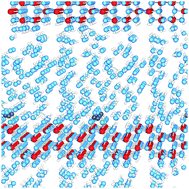Adsorption of oxalate on anatase (100) and rutile (110) surfaces in aqueous systems: experimental results vs. theoretical predictions†‡
Abstract
A combined experimental and theoretical study of the adsorption of

Maintenance work is planned for Wednesday 1st May 2024 from 9:00am to 11:00am (BST).
During this time, the performance of our website may be affected - searches may run slowly and some pages may be temporarily unavailable. If this happens, please try refreshing your web browser or try waiting two to three minutes before trying again.
We apologise for any inconvenience this might cause and thank you for your patience.
* Corresponding authors
a
Institut für Technische Chemie, Leibniz Universität Hannover, Callinstr. 3-3A, Hannover, Germany
E-mail:
mendive@mpi-muelheim.mpg.de
Tel: (+49511) 762-5560
b
Institute of Physical and Theoretical Chemistry, University of Bonn, Wegelerstr. 12, Bonn, Germany
Tel: +49 (0)228 73 3839
c
Institut für Physikalische Chemie und Elektrochemie, Leibniz Universität Hannover, Callinstr. 3-3A, Hannover, Germany
Tel: +49 (0)511 762 2940
d
Chemistry Branch, National Commission of Atomic Energy, Av. Gral., Paz 1499, San Martín, Argentina
Tel: +54 (0)11 6772 7161
e
Postgraduate School, Universidad Nacional de General San Martín, Peatonal Belgrano 3563, 1o piso, Pcia. de Buenos Aires, Argentina
Tel: +54 (0)11 4580 7264/7300
A combined experimental and theoretical study of the adsorption of

 Please wait while we load your content...
Something went wrong. Try again?
Please wait while we load your content...
Something went wrong. Try again?
C. B. Mendive, T. Bredow, A. Feldhoff, M. A. Blesa and D. Bahnemann, Phys. Chem. Chem. Phys., 2009, 11, 1794 DOI: 10.1039/B814608J
To request permission to reproduce material from this article, please go to the Copyright Clearance Center request page.
If you are an author contributing to an RSC publication, you do not need to request permission provided correct acknowledgement is given.
If you are the author of this article, you do not need to request permission to reproduce figures and diagrams provided correct acknowledgement is given. If you want to reproduce the whole article in a third-party publication (excluding your thesis/dissertation for which permission is not required) please go to the Copyright Clearance Center request page.
Read more about how to correctly acknowledge RSC content.
 Fetching data from CrossRef.
Fetching data from CrossRef.
This may take some time to load.
Loading related content
